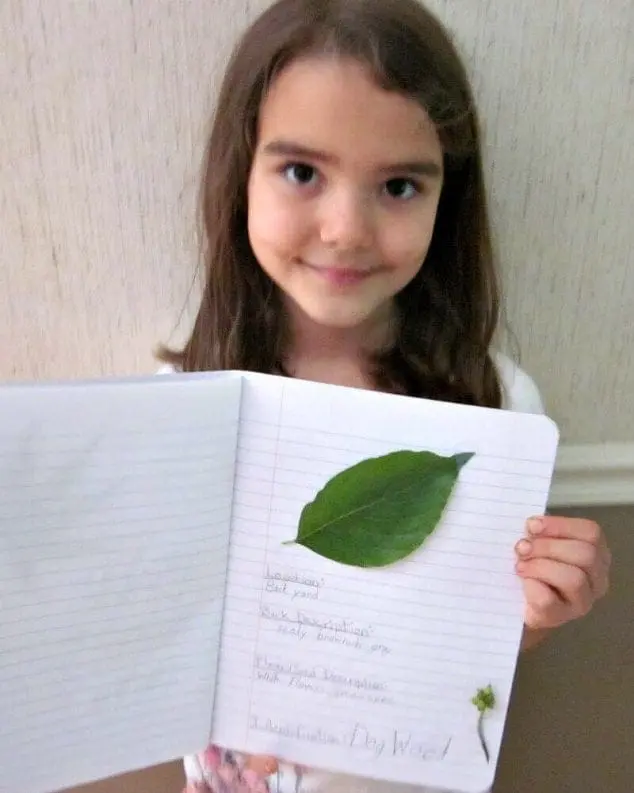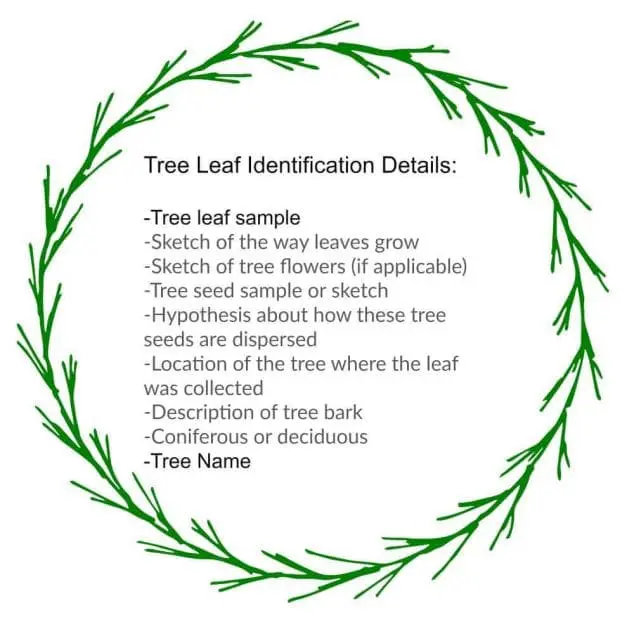If you are looking for an educational project that gets kids having fun outdoors, a tree leaf identification project is perfect! They will actively be learning about science and nature at the same time. Not only will kids have fun hunting for different types of trees, they will also learn tree leaf identification skills that will stick with them for life. Tree identification for kids starts with leaf shape and progresses to other factors to consider for less well known trees. I did a plant journal project when I was a kid and as an adult, I still enjoy being able to identify tree by leaf.
How To Teach Kids About Tree Leaf Identification

Through these tree identification activities for kids, they will learn several ways to identify trees. First, they will learn how to identify a type of tree by looking primarily at its leaves. This is often the easiest way for quick tree identification. You will be amazed how quickly they can pick on leaf identification for kids. Additionally, they will learn to look at the tree bark and tree seeds for further tree identification clues. For example, an oak tree may easily be identified by the leaf shape. However, to discover the species of oaks, you may need to delve further into the tree characteristics.
Leaf Shape Tree Leaves Identification
Tree identification by leaf is a great way to become familiar with the common tree species in your part of North America. Tree identification by leaf can also be a fun and educational activity. Here’s a guide on how to identify trees using their leaves:
Preparation
To begin, you will need to start the tree leaf identification project with a trip to the library. There you can get a tree identification manual or field guide. Or use my affiliate Amazon link.
Alternatively, you can use Arbor Day Foundation “What Tree Is That?” online resource which is a series of electronic field guides. Or download a tree identification app to help identify tree by leaf shape. One example app is the Leafsnap app from the researchers at Columbia University, the University of Maryland, and the Smithsonian Institution. I would suggest using tree identification apps only to double check your own findings. You will learn so much through the process of identification that will be lost if you use the app first.
You will also want to provide your child with a notebook and or a poster board. Here they can record their work as they go. They will need pencil or pen and scotch tape as well.
Tree Leaf Identification Activity Instructions
First teach children how to classify trees. Then, teach them how to identify the tree species using your chosen identification resource guide, online resource, or app. Finally, they can learn to record scientific names and the species of tree.
Make sure children know the difference between coniferous trees (needle-shaped or scalelike leaves) and broadleaf trees (flat leaves). A dichotomous key then be used to help narrow down the possibilities. There is a study lesson about the difference between coniferous trees and deciduous trees here. That basic step is an important part of the tree identification process. Trees which display fall color and usually deciduous so this is a helpful clue in autumn months.
Leaf Type
- Simple Leaves: Single leaf blade attached to the stem. Maple, sycamore, and sweet gum are all examples of Common North American trees. They all have simple leaf structure as do sugar maple, sycamore, elm, oak, and sweet gum.
- Compound Leaves: Multiple leaflets attached to a single stem. Common trees with compound leaves are hickory, walnut, and pecan trees.
How are the leaves arranged on the same twig? Help them identify whether tree leaves are simple leaves or compound leaves. A simple leaf will have a single leaf blade with a bud at the base of the leafstem. A compound leaf, however, has more than one blade. Furthermore, all of these leaf blades are attached to a single leafstem.
More Fun Tree Identification Activities For Kids
Looking for more fun ideas for leaf identification for kids? This tree leaf identification project can be arranged and presented in various ways in order to suit your child’s personality. It can even be adjusted to meet the needs of several children of varying ages.

Make A Tree Identification Book
Older, more patient kids can make a tree identification book. They can work on it over the course of several weeks. Have them set a goal of 5 new tree species each week. This nature journal will be an informative keepsake to have on hand throughout the years! Instead of you using actual leaves, they could use photographs of leaves they have found. This is great if they can’t reach the leaves or prefer not to pick them.
Tree Leaf Identification Chart
Younger children can make a tree leaf identification chart. You can challenge them to divide a poster board into 9 square equal parts. Then, create a display to showcase 9 different tree species that they were able to identify in their neighborhood.
Tree Scavenger Hunt
If you have competitive children in the same age group, you can organize it as a scavenger hunt for trees. Let them see who can turn in the most extensive tree identification book or tree leaf identification chart. Give them a set time period such as 4 hours. You can even provide a bonus point for each way that they can list that trees are beneficial to humans.
Provide A List Of Information Kids Should Gather During These Tree Identification Activities:
This is particularly easy if they are working on making a tree identification book and they can bring the notebook with them into the field as they work. If they are making a tree leaf identification chart they can just work on species at a time before going on to another so they don’t confuse observations.
For Each Tree Species-
- Tree leaf sample
- Sketch of the way leaves grow on a twig
- Sketch of tree flowers (if applicable)
- Tree seed sample or sketch
- Bonus: hypothesis about how these tree seeds are dispersed based on their size and shape
- Location of the tree where the leaf was collected (in case you need to return for further identification help)
- What the bark of the tree looked like (color and texture)
- Coniferous or Deciduous
- Tree Name (The identification can be done as your go or all at once back home.)
Depending on the child’s age, more or less involvement will be necessary. You will also want to follow up to see if they make the correct tree identifications, if they have unanswered questions, and of course, to look at and praise their scientific work!
Tree Leaf Identification Printable
You can print the image below to paste into the front of their homemade Tree ID Book to make it easy if you like.

This homemade tree identification book will be handy to refer to in the future and it makes a great keepsake as well.
Example Of How To Identify Tree Leaf and the Three Most Deciduous Common Trees
- Oak
- Type: Simple (Single leaf blade attached to the stem.)
- Arrangement: Alternate (Leaves are staggered along the stem.)
- Shape: Lobed indentations that go partway to the midrib (deep, rounded or pointed lobes)
- Margin: Lobed (Projections that create deep indentations.)
- Maple
- Type: Simple (Single leaf blade attached to the stem.)
- Arrangement: Opposite (Leaves are directly across from each other on the stem.)
- Shape: Palmate lobed indentations that go partway to the midrib (5 lobes)
- Margin: Lobed (Projections that create deep indentations.)
- Ash
- Type: Compound (Multiple leaflets attached to a single stem.)
- Arrangement: Opposite (Leaves are directly across from each other on the stem.)
- Shape: Pinnate compound (5-9 leaflets)
- Margin: Smooth or finely toothed
Conclusion
I hope you and your child enjoy this tree leaf identification project a great way to get the kids active outdoors and learning about their environment at the same time. This is a fun activity that can be done by one child or by a group of children together as a race. Start with a few common trees in your area and get familiar with their leaf shapes, arrangements, and other characteristics. As you gain confidence, expand to more diverse and less common trees. Happy identifying!
This is a great way to share your love of the natural world with your child. Which tree identification activities for kids do you think your child will enjoy the most? Tag us (#familyfocusblog) in your tree species photos with the name of the tree. We can’t wait to see how many native trees you able to identify!
Related Posts:
Shaving Cream Painted Leaves: A Fall Art Project
How To Make A Magnolia Leaf Wreath- Craft For Kids

Sunny says
Hi scarlet, as usual you are the best blog writer. Thanks for sharing these tips to identify trees by leaves. What a great project to basically make your own tree field guide for your region! Leaf shape tree leaf identification is such a great skill to learn.
Rumi says
Thanks for the tips on how to identify a tree by leaf shape. Very cool leaf project journal idea too for logging new plant species that you identify!
Taniya Akter says
This article is really very interesting and helpful. I have always wanted to be able to identify the type of tree just by looking at the leaves. These tree leaf kids projects will be perfect for my kids and I to learn together.
Martha says
What a fun and educational post! Learning to identify trees by their leaf shapes is such a great way to help kids connect with nature. It turns every walk outside into an adventure and builds observation skills at the same time!
Bella says
I love this! A tree-leaf identification project for kids is such a clever blend of nature and learning—great for autumn outdoor fun and building observation skills. The step-by-step format and printable elements make it extra easy.